|
FAQs about Sea Pens
Related Articles: Sea
Pens,
Related FAQs:
|
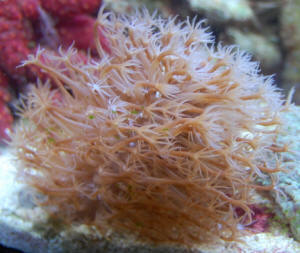
|
|
Hitchhiker IDs 8/15/15
Hello.
<Sarah>
I am needing an identification on two hitch-hikers that have made their way into
my tank.
The anemone? looking thing appears to be multiplying.
There is a smaller one beside it now. I am wondering if this IS an anemone or
some other type of coral that resembles an anemone?
<Mmm; yes; appears to be a Pseudocorynactis... a Corallimorpharian.... can be
trouble... stinging other life. Most folks treat as a pest and remove them. See
WWM Re>
It is clear with white bulbs on the ends of its fingers with a green inner
“core”. Its “mouth” area is different than any anemone I’ve ever seen. Can you
help with an ID for it? I’m most interested if it will harm my seahorses. This
is in a hippocampus erectus tank.
<Will eat your Horses in time>
The second thing is (only one picture) is pink and has pores like there will be
polyps that will come out of it. It is soft but has an underlying structure.
<Mmmm>
This has only been in my tank 24 hours now. I am wondering if this is some sort
of toadstool? It goes down to a V shape that I glued to a small rock then buried
it in the sand.
<Is this... a Renilla?>
Thanks,
Sarah
<Welcome. Bob Fenner>
|
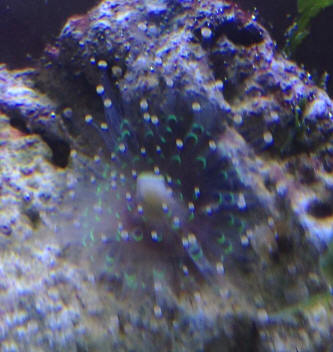
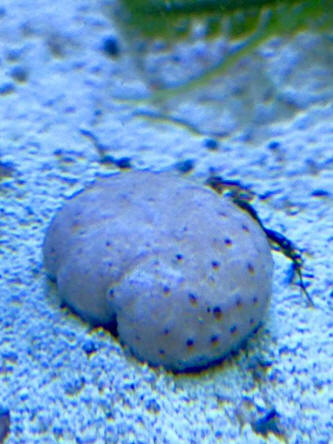 |
My buddy is a diver in Puerto Rico and recently came across
these. 3/12/14
Funny thing, I had seen them while taking the Diver's Den Tour at Live
Aquaria the day before and saw them there. I was told by one of L.A
employees that it's a tunicate.
<Mmmm; don't think so; but... what is this? A sea pansy? A
pleurobranchid?
Are those polyp-like bits another species space-parasitizing this motile
invertebrate?>
I can't find any information on them anywhere. It's just so weird,
almost like a carnivorous plant in the rain forest or from another
planet! Could you PLEASE help me identify them and explain it's
requirements? Many thanks in advance.
http://www.youtube.com/watch?v=qNJTMsr9Yyg&feature=youtube_gdata_player
<Have sent along to LynnZ for her input. Thanks for sharing. Bob Fenner>
: My buddy is a diver in Puerto Rico and recently came across
these. 3/12/14
Funny thing, I had seen them while taking the Diver's Den Tour at Live
Aquaria the day before and saw them there. I was told by one of L.A
employees that it's a tunicate. I can't find any information on them
anywhere. It's just so weird, almost like a carnivorous plant in the
rain
forest or from another planet! Could you PLEASE help me identify them
and
explain it's requirements? Many thanks in advance.
https://www.youtube.com/watch?v=qNJTMsr9Yyg&feature=youtube_gdata_player
<Lynn, what IS this? The movement, lack of identifiable cephalic
region... apparent (though asymmetrical; perhaps another organism)
apparent polyp like life on the dorsal surfaces... What? BobF>
re: My buddy is a diver in Puerto Rico and recently came across
3/12/14
Do you happen to know the requirements for the Sea Pansy?
<Use the words in the WWM search tool... it's on every page. BobF>
Re: My buddy is a diver in Puerto Rico and recently came across
3/12/14
these. Funny thing, I had seen them while taking the Diver's Den Tour at
Live Aquaria the day before and saw them there. I was told by one of L.A
employees that it's a tunicate. I can't find any information on them
anywhere. It's just so weird, almost like a carnivorous plant in the
rain
forest or from another planet! Could you PLEASE help me identify them
and
explain it's requirements? Many thanks in advance.
Hey Bob, that is one bizarre-looking creature! It appears to be a
"Sea Pansy" - a Pennatulacean in the family Renillidae, Renilla sp. Here
are a couple of links:
Renilla reniformis:
http://www.jaxshells.org/slife126.htm
Basic info re: Renilla koellikeri (another tropical Renilla sp.):
http://animaldiversity.ummz.umich.edu/accounts/Renilla_koellikeri/
<.... so; was/IS a sea pansy... Have never seen the principal species off
our coast here in San Diego move THIS quick>
I searched Google for the species and saw one that looked identical, but
couldn't find the species name (got a computer note re: security issue).
At any rate, hope this helps! Wish I had more time to dig up
care/requirements but we're packing to move back to Texas and are up to
our necks in boxes and papers and breakables, oh my! Take care,
Lynn Z
<Thank you my friend; and CONGRATS on your move back to TX! I do hope to
meet with you both there in future. BobF>
Re: My buddy is a diver in Puerto Rico
3/12/14
Many Thanks, it had to be seen to be believed:)
<I'll say! B>
|
ID of the attached creature
1/11/14
Can you please ID the creature as shown in the attached photo?
I have spotted it in my aquarium.
Aquarium data:
10 gallon reef
Salinity: 1025
Temp: 26 C
pH : 8.1
KH : 11
Ca : 420
Thank you!
<A Cnidarian for sure; possibly a Telestacean. Bob Fenner>
|
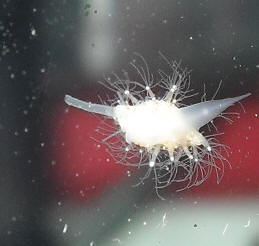 |
|
Strange Creature ID? 9/14/13
Hello all,
<... six and a half megs of pix. What are our requirements?>
I have a strange creature that I would like some help identifying. There
are many of them (over 50 that I can guess) in my 29 gallon BioCube
reef.
It is semi-transparent to opaque-white worm like creature. They are
slender (~1/32"-1/64" diameter when stretched) and long (1-3" long) when
fully extended. It seems as though there are adult versions and newer
smaller versions. They are fixed on a hard surface at their base end and
they don't travel from those fixed points. They are found on my live
rocks as well as in between my Zoas and Green Star Polyps. They have
fuzzy or furry looking appendages all over their length. Their 'head' is
almost Q-tip shaped when fully extended. They extend in the flow
of the currents but can somewhat control their direction of movement if
the flow is slow enough. However, they are only extended in low light or
at night. They will retract and withdraw back into their 'base' in 3 or
4 jerky movements within a second or two when a flash light is pointed
at them. During the day, they are nowhere to be seen except for the ones
attached in dark shaded areas only. At first, they don't seem to affect
anything. They don't affect my soft corals (Hammer, Frogspawn, Duncan,
Leathers, Ricordeas etc. However, I started to notice that some areas of
some of my hard corals (Acroporas) were 'bleaching'. After the
'bleaching', that area began to die off and turn to base skeleton. Upon
further examination at night, I noticed that these unidentified
worm-like creatures were constantly touching the corals on and off.
Those areas that were being touched were bleaching and dying off. I then
scraped the base where a few of these worms (near the Acroporas) where
extending from to try and remove them and noticed that for the next few
nights the worm-like thing was no longer there and within a few weeks
the coral began to heal and regrow in that area.
Taking pictures at night was very difficult and I couldn't get anything
worth sending as they are so thin and almost transparent looking as well
as constantly moving in the current. However, I removed a Zoa plug that
happened to have one of these 'creatures' and dipped it in Coral Revive
for a few minutes. The Coral Revive appears to kill the 'creature' so I
scraped it of the frag plug and was able to take a picture of it. For
reference sake, the base of the black container is ~2" across.
Any help with ID'ing this would be greatly appreciated. Thanking you in
advance.
Regards,
Nick
<Mmm, my best guess is that these are Pennatulaceans. Bob Fenner>
|
.jpg)
.jpg)
.jpg)
Re Strange Creature ID? 9/15/13
Lynn, what do you think? Pennatulacean? B
Re: Strange Creature ID? 9/15/13
Lynn, what do you think? Pennatulacean? B
<That would be my guess as well. Here's a link with some examples for
Nick:
http://www.accessscience.com/loadBinary.aspx?filename=496200FG0030.gif
Take . Take care, Lynn>
<<Thank you Lynn. B>>
Re: Strange Creature ID? 9/15/13
Hello Bob,
I sincerely apologize for the previous large sized attachments... I had no
idea that they were over 6 megs.
I've attached 2 much smaller sized pics for you to view.
My other questions that I forgot to ask are:
a) are they as harmful as I think? and if so
b) is there any way to remove them other than by physical means? I notice
that none of my clean up crew or shrimp touches them.
<Likely not very harmful, though are Cnidarians... and very likely will just
"go"; pass on their own. I would not make extraordinary action to eliminate
nor remove them>
Thank you for taking the time to view the pics and answer my questions.
Regards
Nick
<Ah, welcome. BobF>
|
|
coral identification problem 1/19/11
Sir or Ma'am,
<Jonah>
I have been searching for the identification of this coral for
several months.
<Mmm, I don't think this is a coral... not an Alcyonacean
or Scleractinian definitely>
http://s100.photobucket.com/albums/m22/jonahmazz/coral%20id/
I have posted pics of it several times on reef central and no one
seems to have a good answer.
If you guys can help it would be greatly appreciated.
Thanks much!
<From the gross shape, "tentacles" I suspect you
have a Pennatulacean here... a Sea Pen. Bob Fenner>
Jonah
Re: coral identification problem
Thanks bob!
<Welcome Jonah. Please send along any further ID, pertinent
husbandry info. you gather. BobF>
|
|
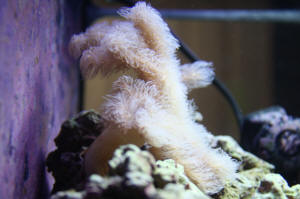 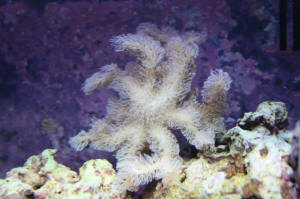
|
|
Sea Pen Behaviour, mortuus est --
01/30/10
Hi
I just got a White Sea Pen which seemed to be doing fine at
first.
<... Pennatulaceans are not easily kept... need a good sized,
well-established refugium and possibly food culture outside the
system...>
Two days after my purchase, I turned on the light in the early
morning to find it had moved about 2 inches from it's
original spot and it is now upside down. Is this normal
behaviour?
<For dying, yes>
I've attached two photos- one before and one after. Any
advice/help would be appreciated.
Bill
<Read here: http://wetwebmedia.com/seapenfaqs.htm
and more widely in marine aquarium and reef invertebrate books re
this group of Cnidarians. Bob Fenner>
|
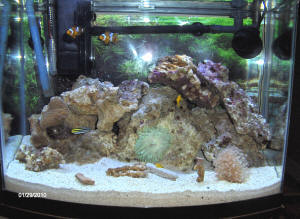 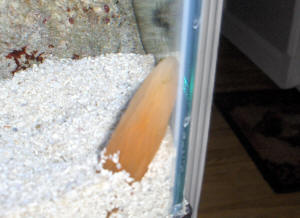 |
|
Re Sea pen 1/30/10
Hi
It's Bill again. All my levels check out fine and food is
readily available.
<... not the types of chemical, biological foods this animal
needs Bill>
Any thoughts on why this is happening? What, if anything, can I
do?
<... these species live in mud/muck/silt... not gravel...
>
I spoke to the store where it was purchased and they said
they've never heard of this before.
<Am sorry, but heard of what?>
They suggested moving it and I have. I'm waiting to see what
happens but if there is anything I can do, I'd like to know-
I don't want to sit and watch it die.
Bill
<I'd return this specimen... stat. BobF>
re: sea pen 1/30/10
Thank you for your help. I think it may be best to return it.
<Is, I assure you>
It's a shame when, at the end of the day, you walk away
feeling like some pet suppliers will sell for the sake of the
sale as opposed to helping hobbyists in making purchases that are
in their best interest.
Bill
<An unfortunately too common event. Cheers, B>
|
|
Unknown Coral Species Possibly Invertebrate?
(Hee-hee'¦aren't they all?) --
04/20/09
Hi,
<<Hello>>
I'm sort of embarrassed to ask a question about a species
identification, especially with so much information available
over the net, at the LFS or the library. But in all honesty, I
have Googled for hours and have stopped in every fish store to
ask questions and still have no answers. (didn't make it to
the Library)
<<Okay>>
I bought what I thought was a Xenia in one of the many stores
that I frequent, I bought it thinking that I was well read and
knowledgeable enough to take care of a new addition to my
tank.
<<But'¦>>
I picked out what I wanted, a light brown healthy looking Xenia
with tentacles that started at the foot that was buried in the
sand, and extended up about 3 inches.
<<Not a Xenia then 'are 'encrusting'
organisms>>
The shape is like a Christmas tree,
<<And this is your first clue>>
full at the bottom, gradually becoming smaller at the top. I
walked away from the specimen tank to defend a poor little clown
fish that was being picked on by bigger bullies and did not
observe the employees putting my prize of the day in the plastic
container, so imagine my surprise when I get home and see this
brown looking morel mushroom looking thing suspended in
saltwater.
<<A good analogy>>
(pick morels in woods every spring) Where's the waving
tentacles and the little fingers at the end of the tentacles? So
I fight the urge to drive back to the store, 50 miles away, plus
the store was closed for the evening and I removed the brown
wilting looking mushroom thing from the bag and have no clue what
to do with it because it has a soft foot with nothing attached to
weigh it down or prop it up.
<<Yup'¦another clue>>
First time I have had to deal with this, I always get coral that
are attached to frag or rock. So I bury the foot in the sand,
<<A good move'¦>>
until the little bugger is somewhat upright. An hour or so later
the tentacles start to creep out of the cap, woo hoo!!, the fish
store people didn't switch a slimy mushroom for my Xenia. I
turned off the tank light and went to bed. Next morning, I come
downstairs and go straight to my tank and my poor half Shroom and
Xenia are gone.
<<Clue number three'¦>>
Nothing there, vanished. I start on the morning tank regimen and
come back an hour later to turn the skimmer back on and low and
behold there is my Xenia waving around in the current.
<<A good sign>>
Now I am just dying to know how my Houdini Xenia just disappears
and reappears, so I check the tank every hour or so and about 8
hours later, he starts shrinking, pulls all his tentacles so far
into that funny little mushroom cap that you wouldn't even
know that he had tentacles and he just got smaller and smaller,
burying himself in the sand, until he disappeared.
<<Ah yes'¦>>
Next morning he pops up right against the tank wall, about 3
inches away from where he buried himself. I sort of push him a
couple of inches away from the wall
<<Mmm, careful 'best to let this critter pick
its own spot>>
and he happily waved his Houdini arms and fingers around for
another 8 hours and disappears. Next morning he pops back up
against the tank wall, where he is currently residing.
<<Ah'¦>>
What do I have?
<<The description and behavior you describe sounds very
much like a Sphaerella or Studeriotes species of soft coral
(http://www.wetwebmedia.com/paralcyoniidae.htm )'¦some
common names are Christmas Tree Coral, and Medusa
Coral>>
I cannot find any information on Xenia's that retract their
tentacles and bury themselves in the sand.
<<Is not a Xeniid>>
I can't find any information about an invertebrate with
tentacles like a Xenia.
<<Try a Google search on the Latin and common names I
listed and see what you think>>
All the fish store employees just look at me funny and think that
I am a twit who shouldn't be within 10 feet of an
aquarium.
<<But, they don't know what this coral is
either 'right? >>
Do I care for it like a Xenia?
<<Mmm, no 'this is an azooxanthellate coral that
requires direct supplemental feeding 'and much like
Dendronephthya species, is not easy to keep. To be honest, I
don't give you good odds for maintaining this animal for long
as it will likely starve to death in a few weeks to months. You
can try feeding small meaty foods like Cyclops-Eeze, Rotifers,
etc'¦but in my experiences these animals always slowly
shrivel away and die. I think the best thing would be to return
this coral to the LFS for a refund/store credit>>
Houdini seems to be doing okay for now, but I'm concerned
that it will decline in the future if I am not treating it
accordingly to its species.
<<Even so 'there's not a lot of info on the
'successful' care of this genus>>
I will try to send photos of his tricks, it's just a matter
of catching him doing them.
Thank You for any information at all.
Beth
<<Sorry it's not better info'¦
EricR>>
Re: Unknown Coral Species Possibly Invertebrate?
(Hee-hee'¦aren't they all?) --
04/20/09
Hi Eric,
<<Hiya Beth>>
Thank you so much for the quick response.
<<Quite welcome>>
I apologize for the ignorance.
<<No worries my friend 'you're smarter than
you were yesterday, eh? [grin]>>
I really did research Xenia's but I guess, I am not
knowledgeable enough to pick them out in a line-up.
<<An honest mistake, I'm sure>>
I live outside of Cincinnati and bought the coral in Dayton and
although I could probably trade it or get my money back, do I
really want to give Houdini back to a store that sold him as a
Xenia in the first place?
<<Mmm, well 'one of the best things we can do is
to educate ourselves/others not to purchase such
animals 'or to return them when done after-the-fact.
If the store can't sell it, then hopefully they won't
order it in next time>>
Personally, I would rather lose the money as lesson learned and
give him to someone who is equipped and knowledgeable enough to
take care of him.
<<A fine sentiment 'but what about the next
time, and the next time, and the next
time'¦?>>
(let me know if you know of someone)
<<Unfortunately there are few folks willing or able to
devote to and maintain the specialized setup
necessary>>
I included a picture of Houdini and I briefly researched both
Studeriotes and Sphaerella as well as Medusa and Christmas tree
corals. I haven't been able to find a photo that looks like
mine but the described behaviors are on the nose.
<<Ah yes! It is now clear that what you have here is a
species of Cavernularia'¦likely C. obese. Commonly
called Sea Pen (though there are several similar genera/species
also referred to re)>>
If you believe that it is not a Studeriotes or Sphaerella, then
I'll try to take some photos of his disappearing antics later
this evening.
<<Not necessary 'am certain this is a
Cavernularia based on your earlier description and these photos.
And the prognosis may not be as dire as earlier perceived. Many
species of Sea Pen are nocturnal and azooxanthellate as described
in our earlier exchange 'the fact that this specimen
comes out when the lights are on is a good indicator that it is a
photosynthetic species>>
If you want, you can tell me that I wasn't a knuckle head for
thinking that it was a Xenia. Or you can tell me how you really
feel and call me a raving Hulk sized knuckle head.
<<Mmm, not at all'¦ There 'is' a
remarkable resemblance 'especially to the
uninitiated>>
Just a note, the folks at the fish stores had no idea what it
was, one guy said that it could be a wild anemone and then showed
me Aiptasia.
<<(sigh)'¦ Sad indeed'¦>>
Also, please do not think poorly of my tank upkeep.
<<Oh?>>
I have been gone for the last two weeks to take care of sick
relatives.
<<Sorry to hear>>
I have only been home twice these last two weeks, I tell my boys
that I missed them and that is why I made the over 200 mile drive
back home, but I really just want to check on my aquarium to make
sure that everything is still alive.
<<Hee-hee'¦I'll never tell!>
This time I had a red algae bloom. The boys had been leaving the
light on for too long, which is better than the last time when
they hadn't turned the protein skimmer on for almost a
week.
<<Hmm, sounds like a lighting timer is in order (your tank
really would appreciate the regularity)'¦and maybe
someone from the local aquarium club to check in once in awhile
(if a possibility)>>
I have to leave again for another week and am terrified about
what I'll find when I come home again.
<<Yikes'¦>>
Crossing my fingers and praying that they take care of the
tank.
Thank you so much for your help.
Beth
<<Always welcome 'safe travels. Eric
Russell>>
|
 |
Care of Atlantic Renilla sp. 12/28/07 Howdy Crew -
Found a couple of half-dead Renillas that washed ashore a few days ago.
We seem to have recuperated them in a tank with 6" of local sand
(very fine/silty). Any recommendations on long-term care? <Mmm, not
finding much on the net re these Pennatulaceans practical care... Are
microzooplanktivores... predated by some Seastars and urchins...>
Namely, would like to replace the existing sand with that from a mature
tank (aragonite bed), and add some live rock along the edges of the
tank for nutrient/waste turnover. No other stinging organisms in the
tank; can connect to a plankton reactor for constant flow of food.
<I do think you're on the right path... or at least have vision
of it. I would read what you can... more generally... re Sea Pansy, Sea
Pen care...> Thanks.. -A <Welcome. Bob Fenner>
Sea pen with a BTA 10/12/05 Hi guys <Hello Daniel> If I
put a sea pen on the other side of the tank from my bubble-tip anemone,
is that OK? Or will they eventually find each other and have a sting
off? <Daniel, I don't know how experienced you are, but Sea Pens
are moderate to difficult to maintain in the aquarium. They do require
a deep sandy bed, moderate to strong lighting, frequent feedings of
micro-plankton, and additions of iodine, calcium, strontium and other
trace elements in order to have a chance to survive. It is not
recommended that you keep anemones with corals or other similar animals
as the anemone will eventually move and sting them. James (Salty
Dog)>
Sea pen coral unhappy ? I've just added a sea pen coral
to my reef tank. when I saw it at the LFS, it was beautiful and looked
a lot like a xenia. its just been in my tank for a few hours, but its
shown very little activity and looks a lot like a flesh-colored
cucumber or a hot dog. its begun to plant its "foot" in the
substrate and a few polyps have started to open up. other than that,
its very "limp" and its stalk is at a 90 degree angle with
the "foot:" in the substrate the rest of the body falling
over onto the sand. <Very typical for Pennatulaceans to
"act" this way on being moved... and they do de/inflate
periodically... most a turgid only at night time> I'm really
hoping that this type of coral <Mmm, not a "coral"... a
pet peeve of mine. Please read re> just acclimates this way but for
some reason I am very worried. I've got decent water flow and when
the coral is not directly under a 96W PowerCompact, it has its very own
3/4W blue LED moonlight. <Uhh, not photosynthetic life> if you
guys could shed some light on my situation, I would greatly appreciate
it. it literally just looks like a brown, bent pickle, haha thanks guys
<Read re these animals on WetWebMedia.com Bob Fenner>
Sea Pens 10/17/03 First off, thank you for the time you spend
helping out people like me. I have searched Google on Sea Pens, namely
Cavernularia. I have found close to nothing. Though your site has a few
lines about them, it is not enough to go on. I was wondering about
light, water movement, and food requirements. Anything else you have
would be helpful. Thanks... <not much has been published on this
unique creature because it is staggeringly difficult to keep in
captivity for long. Few see more than a year old in aquaria with most
dying well before that. They too often get put into rocky reef
aquariums with many other corals that chemically if not physically
outcompete them. They also require very deep and mature sand beds
(6-8" deep and one year old minimum) in nearly fishless systems or
with massive refugia to supply plankton and nutrients. Sea Pens
naturally occur in soft substrates like mud flats and are not found on
the reef proper. Frankly, I regret seeing many collected at all. To be
available just for aquarists that special order them for dedicated
species tanks only in my opinion. My advice would be to post on some of
the big message boards looking for lurkers with experience to share if
you will be kind enough to set up a species tank for your intended
specimen(s). Anthony>
|
|

